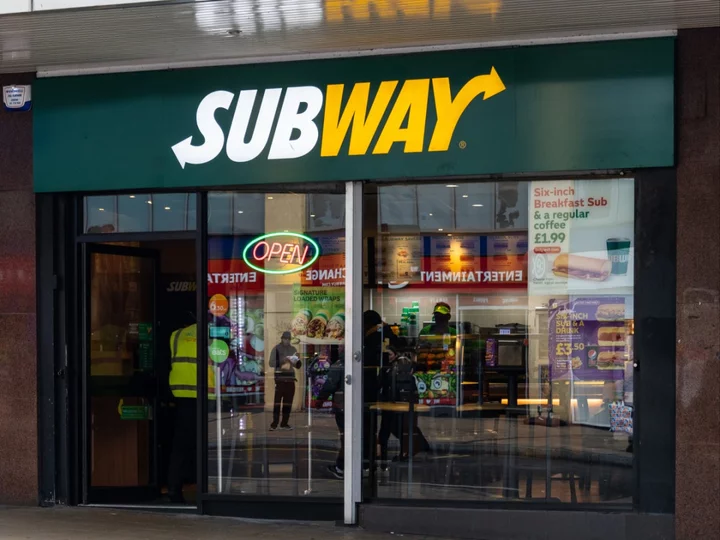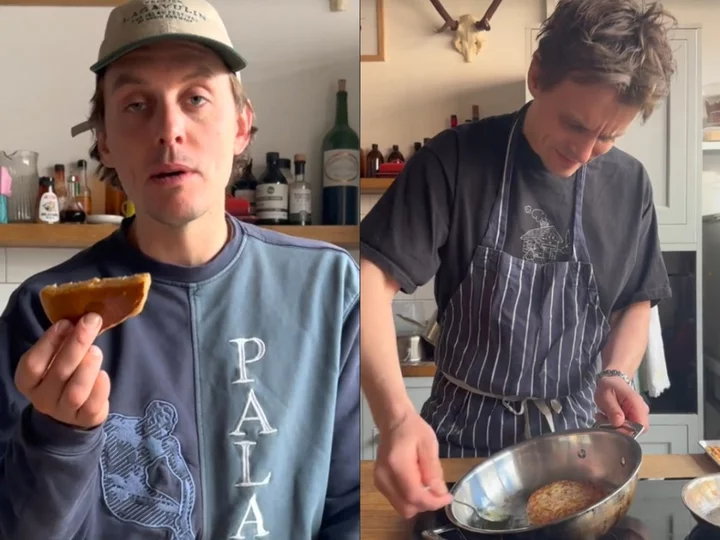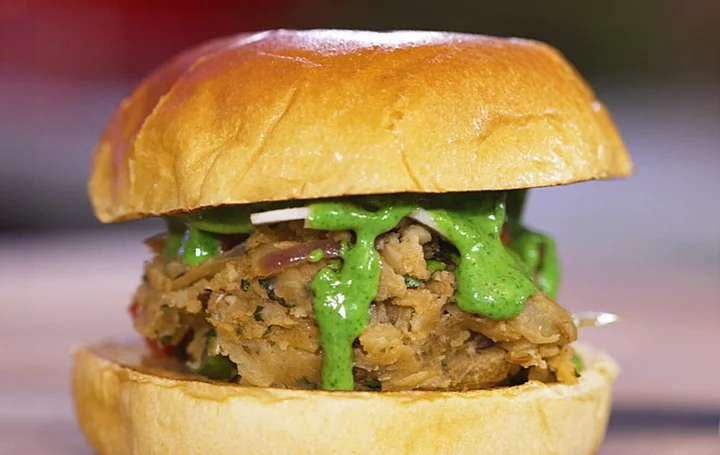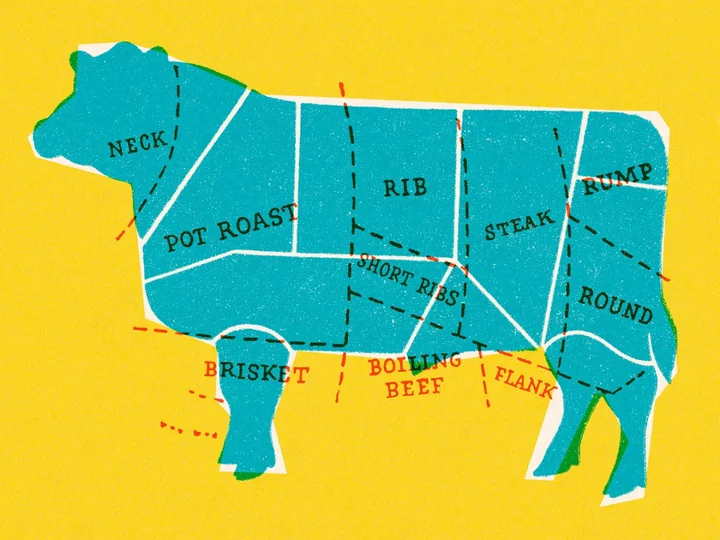
Strictly’s Amy Dowden shares health update following second cancer diagnosis: ‘Not looking forward to this’
Amy Dowden has admitted that she is “not looking forward” to undergoing a procedure that will leave her with a permanently visible scar. The Strictly Come Dancing star, 32, underwent a single mastectomy to treat stage three breast cancer after she was first diagnosed in May. But last month, she was told she needed chemotherapy after further tumours were discovered following the surgery. In her latest update, the professional dancer shared a hospital selfie taken in the bathroom mirror, which showed her wearing a hospital gown and a face mask. She wrote over the photo: “Really not looking forward to this! Another scar this one only [an] inch long but will always remind me and will always be [visible].” Dowden also shared a series of photos from the procedure, which saw her getting fitted for a port for chemotherapy. Dowden wrote in the caption that she wanted to share her journey as she undergoes the treatment to “hopefully get others checking and for understanding what we go through”. “Wasn’t looking forward to it. Wasn’t easy... My veins! Feeling tender, bruised and sore but the port will help massively over the next few weeks and allow me to dance when I feel well enough,” she continued. “A port sits under the skin and the tube goes along my vein to the heart giving safe access for chemo (I believe. I’m no doctor!).” It comes after Dowden, who also suffers from Crohn’s disease, revealed in an Instagram Live chat with breast cancer survivor and Paralympian Erin Kennedy that “everything changed” for her. “I was originally going to have a lumpectomy, radiotherapy and hormone treatment. But then, after my MRI, they found another tumour so then it changed into a mastectomy and then, after my mastectomy, unfortunately, they found even more tumours,” she explained. “They found another type of cancer and then they told me I needed chemo – for me that was a massive blow. It wasn’t in the plan, originally – and I know the plan you can’t get fixated on.” She expressed fears that chemotherapy would stop her from her dance practice, adding: “You can take away my boob but you can’t take my dancing away from me and that’s what I get really upset about.” After her initial breast cancer diagnosis, Dowden was optimistic that she would be able to return to Strictly this year. However, her new treatment means she will not be able to do so in a competitive capacity. “This year, it means I’m not going to be able to dance with a celebrity on Strictly, but I’m in such regular contact with the team – the BBC have just been utterly incredible,” she said. Last week, Dowden made an emotional return to the set of the dance competition to see all her colleagues ahead of her treatment. In an Instagram Story update, she revealed she had surprised her friends on set and said: “I had happy tears to see them all. I got to watch some of the dancing, catch up with them all and hear some exciting plans for this series. I am excited for you guys, it is going to be absolutely brilliant.” Dowden first revealed her diagnosis in hopes it would raise awareness around the disease alongside her existing work on Crohn’s, a lifelong disease that affects parts of the digestive system. In 2020, she fronted a BBC documentary about how her life has been impacted by Crohn’s, titled Strictly Amy: Crohn’s and Me. Dowden is married to her long-term partner Benjamin Jones, who is also a professional dancer. They wed in 2022. Read More A psychic said she’d spoken to my late partner’s spirit – and I didn’t like it Prince Harry’s eco-tourism company quietly announces new board of directors - and he’s not on it Bakery delivers brilliant response to ‘well-known celebrity’ offering ‘exposure’ in return for free cakes Amy Dowden announces absence from Strictly Come Dancing due to chemotherapy Psoriasis Awareness Month: Everything you need to know Mandy Moore opens up about her two-year-old son’s Gianotti-Crosti Syndrome diagnosis
2023-08-01 15:21

Subway offers free sandwiches for life contest if you legally change your name
American food chain Subway has launched a “free sandwiches for life” contest for anyone willing to change their name to “Subway.” The sandwich company announced the start of their new customer competition this week with a desirable “Deli Hero” prize. One fortuitous winner who would legally change their name to “Subway” will be picked to get free stacked meat and double-cheese subs for the rest of their life. From 1 August to 4 August, any adult can go online to SubwayNameChange.com to enter and potentially win a lifetime of “Deli Heros”. “Subway is looking to reward its biggest fan with free subs for life if they legally change their first name to Subway,” the announcement on the company’s website read. “Subway brand love and dedication run deep, especially when free sandwiches are up for grabs.” All fees associated with changing the winner’s name will be covered by the company, but the winner must consent to a background check and provide the company with proof they changed their name within four months of being picked. Then, they will receive $50,000 in Subway gift cards. This isn’t the first time Subway has promised one lucky contestant a lifetime of free subs. “In 2022, one superfan camped out for two days to get a footlong tattoo of the Subway Series logo in exchange for free Subway for life,” the chain declared in the announcement. Subway introduced their “Deli Hero” menu item this month when their plans to invest in fresh slices of meat were underway. The food chain spent more than $80m buying and installing new meat slicers in over 20,000 locations. Since then, Subway has reported moer than $2m in sales for the “Deli Hero” pick, according to a CNN Business report. In 1965, Fred DeLuca co-founded the company with the financer Peter Buck. Back when there was only one sub shop in Bridgeport, Connecticut, the name was “Pete’s Super Submarines.” Now, the restaurant has more than 42,000 locations across 100 countries. According to a 2020 Business Insider report, “Subway has the most locations of any fast-food chain on the planet.” In terms of sales, McDonald’s is the number one fast-food chain. Per The Takeout analysis, McDonald’s reported $48.7bn and Subway reported $9.2bn in sales in 2022. Read More Subway launches bizarre Creme Egg sandwich — but they’re only available in four stores The biggest new vegan launches to know for 2023, from Pret to Wagamama Subway sandwich chain co-founder Peter Buck dies at 90
2023-08-01 05:56

Mandy Moore opens up about her two-year-old son’s Gianotti-Crosti Syndrome diagnosis
Mandy Moore has opened up about her two-year-old son Gus’s diagnosis with Gianotti-Crosti Syndrome, a rare skin condition that develops during childhood. The 39-year-old actress detailed her son’s condition in a series of posts on her Instagram Story. She explained how Gus, who she shares with her husband Taylor Goldsmith, woke up with an unidentifiable rash on 29 July. According to Moore, Several doctors were unsure of what exactly the rash was but ultimately ended with a diagnosis of Gianotti-Crosti Syndrome. “This sweet boy woke up with a crazy rash on Saturday am,” Moore wrote over a photo of Gus holding a lollipop inside what looked like a doctor’s office. “We thought maybe an eczema flare? Poison oak? Allergy. We tried to deduce what it could be and did anything to help him find relief from the itch.” She continued: “Went to urgent care. Paediatrician. Dermatologist. Paediatric dermatologist. All the while, he smiles and carries on like the rockstar that he is.” The following photo displayed a close-up of Gus’s legs and feet covered in raised red patches. “Turns out it’s a viral childhood rash that just spontaneously appears called Gianotti-Crosti syndrome. It’s all over his legs and feet (ouch) and the backs of his arms but nowhere else,” the This Is Us star wrote. “There’s nothing to do but a steroid cream and Benadryl at night. And it could last six to eight weeks. Ooooof. Anyone ever experience this?” Moore added a final slide of Gus from a different day and admitted to the struggle she’s endured as a parent. “All of that to say, this parenting thing is weird and hard and sometimes you feel so helpless (and yes I’m ever so grateful it’s only an itchy skin condition). Kids are resilient and as long as he’s smiling through it, we are a-okay,” the creator noted. According to WebMD, the rash can also be referred to as “papular acrodermatitis of childhood,” and affects the legs, arms, and face. Viral illnesses can bring about this rare condition and can appear while “your child is recovering from another illness”. Children between the ages of nine months to nine years old are more likely to develop the rash. However, it’s not impossible for adults to get it. “The rash often first appears on or near the buttocks, then spreads to the arms, legs, and face. The blisters vary in size and may be filled with fluid. They may be pink, red, or brown in color,” WebMD said. Swollen lymph nodes and a mild fever are symptoms of the skin condition too. Although the rash may take anywhere between four to eight weeks to heal on its own, little to no scarring should be left on the skin. In 2021, Moore gave birth to Gus, short for “August,” before having her second baby, Oscar ‘Ozzie’ Bennett. The Tangled Ever After voice spoke about the gratification she and Goldsmith felt at the end of each day in her 31 May post. “These dudes rule my heart. Each night, Taylor and I fall into bed after we’ve put them down; after we’ve straightened up from the chaos of dinner/bath and set up for the next morning and we chat about the day,” the actor proclaimed. “I wouldn’t have it any other way. I mean, I do look forward to feeling moderately well rested sometime in the next decade? But [shrug emoji].” The photo showed Gus and Ozzie staring at each other on a picnic blanket at the park. Read More Netflix lists $900,000 AI job amid SAG-AFTRA strike for protections against ‘scary’ technology Mandy Moore shares struggle with potty training her toddler son: ‘It’s wild’ Mandy Moore gives birth to her second child Experts reveal why you keep waking up at 4am, and how you can prevent it Mum with stoma bag shares bikini pictures to celebrate ‘second chance at life’ Charlotte Dawson gives birth to her and Matt Sarsfield’s ‘rainbow baby’
2023-08-01 02:25

London chef apologises after criticism for all-white, all-male kitchen team
A London-based chef has apologised for what his peers branded a “rude” response towards criticism, after he faced backlash online for revealing the line-up of his kitchen team at his Notting Hill restaurant. Thomas Straker, who opened his namesake restaurant Straker’s in 2022, recently shared a photograph of his “chef team” comprising eight people, including himself. All eight members of the team pictured were white and male, prompting complaints from social media users who believed it did not reflect the diversity of London. Some comments claimed Straker’s team showed how the food industry was a “white boy’s club”, while others urged the restaurateur to provide chefs from minority groups a “safe place to grow as chefs”. Straker, who found fame by sharing his recipes and cooking videos on TikTok, responded to the negative backlash by commenting: “Honestly, people need to calm down. Firstly, there is a shortage of chefs/hospitality workers. Secondly, if you feel so passionately, please go and gather CVs of any chefs you think we’re missing in the team. Solutions not problems. Thank you.” However, his response has also been criticised as “rude”, with a number of chefs and other figures in the food industry weighing in on the online storm. He has since shared an apology via his Instagram Story. “On Friday night, I put up a post of my chef team and many rightly pointed out the lack of diversity in it. I am very sorry for my initial response, where some queried whether I take this issue seriously,” he said. “I am absolutely committed to ensuring diversity in my restaurants, unfortunately we aren’t achieving this in my kitchens currently and this is an area I know I need to improve on, making sure it is seen as a welcoming and approachable environment for all. Tom x.” Becky Paskin, a drinks expert who appears regularly on ITV’S Love Your Weekend, wrote on Straker’s original post: “Too often we say, ‘We only recruit on the basis of the best people for the job’ without any consideration the role bias plays in the selection process. “It’s been proven time and again that diverse teams are more creative, productive and successful. If every member looks the same and has the same background, you’ll find they’ll all think the same as well. Forming diverse teams is not only the right thing to do, it makes business sense too.” US chef Kenji Lopez-Alt, who is known for his book The Food Lab: Better Home Cooking Through Science, added: “Get off the social media for a week or so. Do some reflection. Talk to people who care about you and who you trust. Be better.” However, some people have defended Straker’s choice to hire who he wants in his team, and pointed out the staff shortage affecting the entire restaurant industry. Henry Tilley, restaurant manager at Native in London, wrote: “The industry is on its knees right now. There [aren’t] enough chefs or even [front-of-house staff] to go around as it is. We would love some applications for chef positions in our restaurants from female or non-binary individuals. The reality of the matter is we never get the applications so can’t be as representative as we’d like.” But Ben Mulock, executive chef of Balans in Soho, says the onus is on senior chefs to “solve the problem” of lack of diversity, instead of “asking others to solve it for us”. He told The Independent: “I am a white male executive chef, so it is my responsibility to push for an inclusive workforce, be that sex, age or ethnicity. They are not mutually exclusive – they are all important. “No, it’s not easy and at the moment, it almost seems impossible to recruit, but if we don’t try, we don’t move it forward. We always need to do better for this industry, and if we can’t do it in London, where can we?” While Straker’s post was not intended to stir controversy, the lack of diversity in his team has “shone a light on the broader challenges we face in kitchens these days”, Hannah Norris of Nourish PR said. “This is a classic case of an ill thought-out post,” she told The Independent. “Thomas Straker has issued what he believed was a photo of a group of confident, strong-looking chefs ready for service but didn’t think about the optics of the image and what it represented. “Whilst it was well-meaning I believe, a picture doesn’t lie. For whatever reason, he currently has no women or people of colour in his kitchen, so it all looks a bit ‘pale, male and stale’. Perhaps the reaction to this image will make Thomas think again a bit more carefully about who he wants to employ in the future.” The Independent has contacted Straker for comment. Read More The dish that defines me: Frank Yeung’s prawn wontons Between Brexit and Covid, London’s food scene has become a dog’s dinner – can it be saved? Prince William serves up vegetarian ‘Earthshot burgers’ to shocked diners Restaurant introduces ‘minimum spend’ that sees solo diners pay double to eat alone Restaurant with ‘tips are a privilege’ policy sparks intense backlash on social media How to make the Prince of Wales’s Earthshot burger
2023-07-31 21:24

How to make the Prince of Wales’s Earthshot burger
The Prince of Wales has teamed up with popular YouTube channel, Sorted Food, to create the first Earthshot Burger. The veggie burger was created with Earthshot Prize-winning products, and a video posted on YouTube shows William handing out meals from a food van in central London with the Sorted Food chefs. The burger, filled with vegetables, spices, pickles and finished with a minty vegan mayonnaise, was developed by the sustainable packaging start-up Notpla (winner of the Build A Waste-Free World category), environmentally-friendly stove company Mukuru Clean Stoves (winner of the Clean Our Air category), and Kheyti’s Greenhouse-in-a-box, winner of the Protect and Restore Nature category. The collaboration is part of The Earthshot Prize’s new partnership with YouTube, to encourage users to create more content around climate change. Here’s how you can make your own at home… The Earthshot Burger Ingredients: (Serves 4) For the pickle: 1 cucumber, 2mm slices 1 mouli, peeled and cut into 2mm slices 200ml white wine vinegar 75g caster sugar 1tsp chilli flakes 1tbsp coriander seeds ½tbsp fennel seeds 1tsp mild chilli powder 1tbsp ground coriander seed 1tsp garam masala For the burger mix: 6tbsp vegetable oil 2tsp cumin seeds 1tsp mustard seeds, brown 1 red onion, peeled and finely chopped 6 cloves garlic, peeled and minced 40g ginger, finely chopped 2 green chillies, finely sliced 1tsp turmeric 1 red pepper, deseeded and sliced 200g white cabbage, shredded 200g cauliflower, finely chopped 100g green beans, finely sliced 500g white potato, steamed and cooled 30g coriander leaves, chopped For the sauce: 200g vegan mayonnaise 60g coriander 20g mint, leaves only 20g ginger, peeled To serve: 4 burger buns, sliced and toasted Method: For the pickle: 1. Place the sliced cucumber, mouli and one tablespoon salt in a large mixing bowl and mix well. Allow to sit for 30 minutes. 2. Add 400 millilitres water, vinegar, sugar and spices to a medium saucepan and bring to a simmer over a high heat. Once simmering, remove the pan from the stove. 3. After 30 minutes, tip the salted cucumber and mouli into a colander and rinse under cold running water then add them to the warm pickle liquid. Stir well and allow to cool. For the burger mix: 4. Heat the oil in a large saucepan over a medium heat. Add the cumin seeds and mustard seeds and fry for two minutes until fragrant and starting to pop. 5. Add the onion, garlic, ginger and chillies, along with a pinch of salt and continue to fry, stirring occasionally for five to seven minutes until the onion is starting to colour. 6. Tip in the spices and stir to combine. 7. Tip in the sliced pepper and continue to cook for five minutes until the pepper softens and releases its liquid. 8. Add in the cabbage, cauliflower and green beans, stir everything together and cover the pan with a lid. Allow the vegetables to soften for five minutes. 9. Coarsely mash the potatoes in a bowl and then add them, along with the coriander to the pan. Stir everything together and taste and adjust the seasoning. You are looking for a thick mashed potato texture. 10. Remove the pan from the stove. For the sauce: 11. Add the mayonnaise, herbs, ginger and a generous pinch of salt to the jug of a blender and puree until smooth. Taste and adjust the seasoning. To serve: 12. Divide the mashed potato and vegetable filling between the toasted buns. Top each with a couple of pinches of pickled vegetables and finish with the herb sauce. Read More ‘Nicely cooked’: Watch moment Prince of Wales serves burgers to surprised diners in London The dish that defines me: Frank Yeung’s prawn wontons Seann Walsh explains reason behind his ‘strange request’ at restaurants
2023-07-31 20:26

The dish that defines me: Frank Yeung’s prawn wontons
Defining Dishes is an IndyEats column that explores the significance of food at key moments in our lives. From recipes that have been passed down for generations, to flavours that hold a special place in our hearts, food shapes every part of our lives in ways we might not have ever imagined. There is a family scene I would love to engrave into my memory that involves my father, myself and my son, all making prawn wontons in one kitchen. Prawn wontons are so simple, like all good dishes, and they have a really special place in my heart. I have very fond memories of making them with my father, who is from Hong Kong, when I was growing up and it is my favourite dish. Now, it’s my five-year-old son’s favourite dish as well and he’s the same age I was when I first started making prawn wontons with my father, so it makes me excited to share the dish with him. When my son was younger, his Ye Ye (grandfather) would bring homemade wontons whenever he came over to my house in Peckham. But just recently, we were over at my parents’ home, and he made his first wonton. We were all very proud! It’s so nice because it’s a dish that has run right through my family, it was brought and championed here by my dad. He moved here in 1975 and has the classic first-generation immigrant story. He worked three jobs, moved around a lot, saved money and opened his first restaurant in 1985, 10 years after arriving in England. He finally retired in 2017, but he couldn’t get away from my restaurants. I opened my own establishment, Mr Bao in Peckham in 2016, and then Daddy Bao in my father’s honour. Even now when he comes around to visit, I make him talk more about restaurants. I think he enjoys it, though, and it reminds him of home. That’s really important now because ever since the 2019-2020 mass protests in Hong Kong, the country is a sad place at the moment if you’re from there. But it’s still an amazing place. My favourite part about making wontons from scratch was always the time spent with my dad. The chit chat between us, me kneeling on a stool and him standing at the counter. My hands were not as dextrous at that age and I certainly wasn’t practised, but he would be there to help show the right way to make the little parcels and finish them up for me. The bonding moment is what I cherish the most. Mum is English and she got involved too, she is actually amazing at it. Prawn wontons are also part of Christmas time for my family. Our big tradition is to have a massive steamboat on Boxing Day, which most people of Chinese descent will be familiar with. It usually involves a big, steaming pot of soup on a constant boil, and everyone sits around the table cooking fresh, raw ingredients in it and eating as they go. Prawn wontons are a big, big part of that meal for us, especially now that we have a couple of young kids running around at Christmas time, they really love it. The thing I remember most about making wontons with Dad is the filling. He has his own method for making the prawn mince that goes inside the parcels. He gets his prawns and chops them up, mixes them with any additional ingredients like garlic, and then he would make me pick up a handful of the mixture and throw it back down onto the chopping board, pick it up and throw it back down. It somehow aerates the mince and softens it, and makes it stickier so there aren’t big chunks of prawns floating around. I haven’t really adapted Dad’s recipe for myself, aside from the type of dipping sauce I like to have with them. We keep it very traditional. Oh, I suppose I do have a slight modification, actually. I like to mix gambas (white) prawns from the southwest coast of Spain with North Atlantic shrimps, which are tiny, tiny little crustaceans the size of your nail. They have got a really good flavour. I like to chop those up into the mince with the bigger prawns, add a bit of salt and white pepper, stir it through and then do the throwing method as my dad does. We usually make our own wonton skins. In a pinch, we’ll use shop-bought ones, but when we know we’ve got time we’ll make our own. At the moment, Dad makes handmade dumplings with my sister for her business so they have a dumpling skins machine – but we used to make them by hand, old-school style. He would roll them out because he could get the thickness of the skins right. It wasn’t possible when I was young as I had no idea and was clumsy! They have to be thin, but not so thin that they break or the wontons will open up in the water. It’s something I haven’t managed to master, but there’s still time. Some places don’t even use the regular wonton skins, and they are still amazing. One of my favourite restaurants ever was in Hong Kong – it has closed down now – but it was a hole-in-the-wall type of place that served two types of wontons: classic wontons or fish skin wontons. That was their entire menu. They used fish skins instead of pastry skins to wrap their wontons, and they were something like £1.20 for a bowl at the time. It was definitely the best meal I had with Mum, Dad and my sisters in Hong Kong. The wontons get boiled for two minutes. You can make a wonton soup with a base stock, using ginger, spring onions, salt, pork bones. Boil that down and skim off the top. Or, you can dip the wontons into a chili garlic sauce, which is how my dad likes – although another way I differ from Dad is that I like to add black vinegar to the sauce of soy sauce, garlic and chili, to add an extra layer of acid. You can also eat them as they are, they are completely delicious. My stomach is rumbling as I think about them. As my son gets older, it will be really nice to be able to make wontons altogether, the three generations of us at the kitchen island, chatting away. That’s what I’d like my son to take away from those sessions, the memory of doing it with his Ye Ye and me. I’d also like him to, in time, be able to link quality to food and what you’re putting in your body. I want him to understand that even though it’s so easy to go to the shop and buy something, everything starts out as a living thing. A prawn is an animal and a chive is a real plant grown in the soil. You don’t have to make it yourself and you should go to restaurants to support them, but when you do go, you’ll have a better appreciation for it. Frank Yeung is the chef-owner of Mr Bao and Daddy Bao in London. Read More The dish that defines me: Alex Outhwaite’s Vietnamese bun cha The dish that defines me: Eddie Huang’s Taiwanese beef noodle soup In Horto: Hearty, outdoorsy fare in a secret London Bridge garden Five dinner ideas from around the world to try this week Hi Barbie! Nine cocktails inspired by the doll’s most iconic outfits
2023-07-31 17:20

Mum with stoma bag shares bikini pictures to celebrate ‘second chance at life’ after cancer scare
A mum who was diagnosed with Crohn’s disease aged 13 and had to have her colon removed eleven years later as it became pre-cancerous, giving her a “second chance at life”, is now an influencer bearing all to show it is possible to “live a beautiful, normal, happy life” with a stoma bag. Meghan Cary Brown, 31, a stay-at-home mum and content creator, from Charlottesville, Virginia, in the US, spent most of her teenage years in “so much pain” and had to “deal with bullying as well as being sick”. At 24, the mum of two, to Cora, three, and 23-month-old Colin, was told her colon was precancerous, causing her to “collapse on the floor crying”, just eight months after she had married Thomas Brown, now 31, a project manager. Meghan was in a “very dark place” and was “overcome with sadness” at the thought of getting cancer, so with some encouragement from her doctor, had her colon removed and had a stoma bag fitted. One year later she created an Instagram page, and more recently a TikTok, to share her story and raise awareness about life with a stoma bag with thousands of followers. Her postings include an open discussion of her experience, sharing bikini pictures and openly explaining she has worn “beautiful lacy wraps” for stoma bags in intimate moments with her partner, and it has “served as a healing mechanism” to make her realise she needs to “stop worrying so much” about the opinions of others. “I started posting as I wanted people to see that you can live this beautiful, normal, happy life with an ostomy bag, and when I was researching it I couldn’t see anyone my age talking about it,” she told PA Real Life “But the other reason was that it almost served as a healing mechanism for me – I think it was really powerful to just put myself out there on the internet. “Like, this year at the beach for the first time I wore a bikini with my bag on show and it felt amazing – I just thought life is too short.” After Meghan was diagnosed with Crohn’s disease she had to be home-schooled for a year because she “could not even get out of bed”. Meghan said: “My parents would find me lying on the bathroom floor because I could not get up and walk to the bed, I was in so much pain, and I had so much fatigue. “But it was also hard because since I was home-schooled, we didn’t have social media or anything, so no-one knew where I was, and there were lots of rumours spread about me – I had to deal with bullying as well as being sick.” Meghan was put on lots of different medications and had to deal with their side effects, such as giving her a “big moon face” as she retained water. She said: “I can remember having to get clothes three times my size and just breaking down crying. “That’s really difficult when you’re a teenage girl.” One year later Meghan was “in remission” for Crohn’s and was able to return to school. She continued taking “maintenance medication” which kept her symptoms at bay but, when she was in her first year of university, she began getting sick again. She explained: “I fell out of remission and it turned out I formed antibodies towards the drug I was taking so it was no longer working. “I had to inject myself at home while in college so it was really difficult.” Meghan also had to have regular hospital visits and aged 24, eight months after getting married, a routine colonoscopy showed that her colon was pre-cancerous. She said: “When they told me I had high-grade dysplasia deep within the tissue of my colon, and it was pre-cancerous, I was heartbroken. “I can remember standing in the kitchen when my doctor told me this over the phone, and it made me collapse on the floor crying because when you hear that word, cancerous, all you can think is that you’re going to die. “It was terrifying.” At the follow-up appointment Meghan was told she could have routine checks to make sure the cancer was not progressing or have her colon removed. She said: “I was adamant that I wasn’t going to have my colon removed – I thought my life would be over if I had that done. “I was in a very dark place and I was overcome with sadness. “But when I told my doctor my decision, he explained that I could have it removed now, or in a few years’ time I could be a mum with young children and have cancer. “That just put things into perspective for me – it made me realise it’s not just about me, so I decided to have it removed.” From that moment on, Meghan decided to live her life to the full. She said: “I decided I was going to look at this as my second chance at life – I had already been incredibly sick for 10 years – I told myself I was going to look at this as a positive thing. “Before, there were so many things I couldn’t do, like I had so much anxiety riding in a car because I couldn’t control my bowels and I was so worried that I wouldn’t be able to find a bathroom.” It took Meghan a few months to get used to having a stoma bag, and she explained what it is like day-to-day: “I change the whole system appliance every three to four days, and throughout the day I have no feeling. “I don’t have the urge to go to the bathroom, it just happens. “Throughout the day I’ll just go to the bathroom and empty my bag – I do this around six to eight times a day.” Meghan also had to adjust to having a stoma bag while being intimate with her husband. She said: “I wore beautiful lacy wraps made for people with bags, with a pocket to tuck it in, as it helped my body image because I felt pretty. “But honestly, now I’ve had my ostomy bag for almost seven years, we’re so comfortable with one another – if anything ever happens during intimacy, we just can laugh it off and move on.” One year after having her bag fitted she decided to create an Instagram account to share her story, where she now has more than 14,100 followers, and a further 19,400 followers on TikTok. Meghan said: “It really puts life into perspective and really made me realise life is so short. “I need to stop worrying so much about the opinions of others, or what other people are going to think – making my Instagram account made me realise this too. “I’m just so happy to be happy and healthy.” Read More Charlotte Dawson gives birth to her and Matt Sarsfield’s ‘rainbow baby’ How to sleep during hot weather, according to experts How to keep your pet safe and healthy during a heatwave Charlotte Dawson gives birth to her and Matt Sarsfield’s ‘rainbow baby’ How to sleep during hot weather, according to experts How to keep your pet safe and healthy during a heatwave
2023-07-31 17:20

Experts reveal why you keep waking up at 4am, and how you can prevent it
Ever find yourself awake, staring into space at four in the morning? Is it just a bad habit, or is there something more sinister going on? And why does it always seem to happen at 4am? “We start to experience less deep sleep after around four to five hours,” says Lisa Artis, deputy CEO of The Sleep Charity, who have partnered with Simba mattresses. And once we’re in that lighter sleep faze, we wake much more easily. If you generally fall asleep around 11pm – which is a very common bedtime, 4am wake-ups are more likely. And there are many factors leading to these inconvenient stirrings. Hormones “Sleep is guided by our internal clock or circadian rhythm. One of the most significant and well-known circadian rhythms is the sleep-wake cycle,” Artis continues. “Sleep is regulated by the levels of two hormones: melatonin and cortisol, which follow a regular 24-hour pattern. Melatonin assists you in dozing off, while cortisol helps get you up, and keeps you awake,” she explains. Keeping an eye on your hormones is important in preventing those late-night wake-ups. “Engage in calming activities before bedtime, such as reading, listening to soothing music, or practising relaxation techniques, like deep breathing or meditation,” says Dr Mariyam H. Malik, GP at Pall Mall Medical. Equally, pop your phone down for a bit. “Blue light from electronic devices can suppress melatonin production. Try to avoid screens for at least two hours before bedtime, or use blue light filters. It is best to charge them in a separate room overnight,” Malik adds. Diet Caffeine, heavy meals, alcohol, sugar, and a lack of magnesium or B vitamins could lead you to have a more disturbed night’s sleep, according to Malik. Sugar and carbohydrates may have a particular impact. “A diet high in sugar and refined carbohydrates can cause blood sugar fluctuations, leading to wakefulness during the night,” she says. “It’s unlikely you’ll feel hungry in the middle of the night if your blood sugar dips,” notes Artis, “but to reduce ungodly hour awakenings, trial alternatives for your last meal or snack of the evening. Instead of carb or sweet-based snacks, opt for protein-packed and magnesium-rich foods, like hard boiled eggs, cottage cheese, pumpkin seeds, spinach, dark chocolate, cashews, chicken thighs or turkey.” Protein can take the edge off your night-time hunger, she says, while magnesium is known to support sleep. Needing a wee Do you wake up needing to wee at the same time every night? “Try not to drink excessive amounts of fluids before bedtime,” advises Malik. “It’s important to stay hydrated, but try not to drink anything for around two hours before your usual bedtime. Go to the toilet before you go to bed to empty your bladder. ” Age and life stage “Sleep tends to become more disrupted as people get older,” Malik explains. “Sleep patterns change with age, and various factors can contribute to sleep disturbances in older adults. Some common reasons for sleep disruption in the elderly include changes in your circadian rhythm, decreased melatonin production, medical conditions or medications, and potential sleep disorders.” It can also affect women during the perimenopause. “The reproductive hormones – oestrogen and progesterone – are entwined with the sleep and relaxation hormones, melatonin and serotonin,” says Artis. “When oestrogen begins to fall before and during menopause, it can create a disturbance in the sleep-promoting hormone melatonin, meaning it can’t properly balance out cortisol. When this happens, the ability to fall and stay asleep is affected.” Recurring hot flushes, night sweats, dry skin, and low libido can signal waning oestrogen. Artis advises incorporating foods with high levels of phytoestrogens into your diet throughout the day to help with this. “Phytoestrogens imitate the natural estrogens found in your body. As a consequence, they can bind to your body’s oestrogen receptors and produce similar effects.” Try lentils, kidney beans, chickpeas, tofu, edamame, spinach, cauliflower and broccoli. Worrying Stress is not good for sleep. One study by Bupa even found that 32 million Brits wake up worrying about their health at precisely 4:05 am. The report, which surveyed 4,000 British adults, revealed that more than three-fifths of us wake up in the middle of the night. If you are finding yourself awake at all hours worrying, or waking up with stressful dreams, there are a few things that may help. “Keep a journal by your bedside and write down your worries before going to bed. This practice can help get your concerns out of your mind and onto paper, making it easier to let go of them temporarily,” says Malik. You may also want to “engage in mindfulness or meditation exercises before bedtime. Mindfulness can help you focus on the present moment, reducing anxiety about the past or the future.” Read More Men have a problem – and it won’t be solved by either Andrew Tate or Caitlin Moran Elon Musk reacts to ex-wife Talulah Riley’s engagement to Thomas Brodie-Sangster Thomas Brodie-Sangster references Love Actually in sweet engagement announcement with Talulah Riley Charity boss speaks out over ‘traumatic’ encounter with royal aide Ukraine war’s heaviest fight rages in east - follow live
2023-07-31 17:19

Charlotte Dawson gives birth to second child with Matt Sarsfield after miscarriage
Charlotte Dawson has welcomed her second child with fiancée Matt Sarsfield, several days after a “false alarm” that saw her rushing to the hospital. The reality star, 30, shared a photo of her cradling her newborn son while laying in a hospital bed on her Instagram Stories early on Sunday morning (30 July). She wrote in the caption: “Guys he’s here!!! I can’t believe it!!! I came in at 1am I had him by 2.13am.” Dawson, whose father was the late comedian Les Dawson, told her 1.3 million followers: “Can’t wait to update you all as soon as but Matthew has nipped to get me a Maccies [McDonald’s] and I’m having cuddles.” Dawson and Sarsfield, who have been engaged since 2020, are also parents to two-year-old son Noah. In another post, showing Sarsfield holding the baby, Dawson wrote: “He’s turned up with no Maccies ffs [sic]. But look at my beautiful baby daddy with our boyo [sic]. All happened so fast but thank you for being amazing Matt.” Several days earlier, Dawson revealed that she was rushed to hospital after her water had broken. However, it was a “false alarm” and she was sent home to wait until she went into labour. The Ex On The Beach and Celebs On The Farm star wrote in a post at the time: “Oh guys it’s been a bloody weird 24 hours… My waters broke last night but no pain, managed to sleep through it. Just getting checked now as movement’s been slow, happier I can hear his little heartbeat now.” Last year, Dawson revealed that she had suffered a miscarriage at 10 weeks that left her “heartbroken beyond words”. Her second baby has been dubbed her “rainbow baby”, a term that refers to a child born after the previous loss of a baby due to miscarriage, stillbirth, or death during infancy. She opened up about how she and Sarsfield were “over the moon” when they first discovered she was pregnant, but later it turned out it was “just not meant to be”. “Miscarriages are so common and not spoken about enough. We are so heartbroken right now, have no words and just don’t feel up to posting being my happy silly self right now,” she said. After learning that she was pregnant again, Dawson said she felt “very blessed and very happy”. “We were absolutely heartbroken about the miscarriage last year,” she added. “It came as a shock when I found out last April. It was like we’d just come to the realisation that we were having a baby and I lost it at 10 weeks.” Read More Blood, guts and cheap cuts: We need an alternative to eating animals – and ‘ethical meat’ isn’t the answer Strictly Come Dancing’s Janette Manrara gives birth to first child with fellow dancer Aljaz Skorjanec Jamie Lee Curtis says it is her ‘job’ to ‘fight’ against transphobia on behalf of daughter How to sleep during hot weather, according to experts How to keep your pet safe and healthy during a heatwave This is why you keep waking up at 4am – and what you can do about it
2023-07-30 18:55

Blood, guts and cheap cuts: We need an alternative to eating animals – and ‘ethical meat’ isn’t the answer
Amber Husain was cooking dinner for a friend when she suddenly realised the meat she was preparing was a corpse. She looked at the chicken in front of her and was overcome with a visceral sense of disgust. Instead of food, she saw “a carcass – plucked, beheaded, and fleshy”. Husain was 26 when she had this epiphany, and it served as a wake-up call not just for her stomach but her mind, too – as her personal tastes shifted away from meat products, her political outlook on the meat industry and food production more broadly also altered and expanded. Five years later, that moment of revulsion forms the opening of her new book, Meat Love, in which she scrutinises the idea of “ethical” meat consumption, and dares to ask how the contemporary middle classes have come to criticise “the worst violence against animals” while still happily feeding on their flesh. Why, for example, has well-heeled, middle-class London gone nuts for slurping bone marrow from the shin bones of baby cows? Why is offal on so many trendy menus? How has contemporary culture at large come to accept that factory farms are monstrous, but that if animals are cared for, cherished and loved while alive, we should feel better about killing them for our carnivorous pleasures? “For ages, I was one of those carnivores who felt mildly bad about eating meat but just turned that into this inane, self-consciously sadistic part of the pleasure of it all,” Husein tells me. “The more my diet started to revolve around stuff that wasn’t meat, the weirder meat started to feel. Interestingly, once my stomach had been radicalised, I found I had a much greater intellectual openness to thinking about the politics of meat.” Having freed herself from the conflict of eating meat but also feeling bad about it, she found she was able to go beyond those questions of morality – which she suggests can be “stifling” – and think politically. “Now that I have no desire to eat animals, there’s nothing to stop me reckoning with what it means that the meat industry [consists of] an underclass of both humans and animals who are exploited and – in the animals’ case – killed for pleasure and profit.” This is the essential crux of Husain’s argument, and it’s something often lacking in discussions around the “ethics” of meat consumption. For Husain, the question is not, “how can humans eat meat responsibly?” but “how are certain lives devalued to an extent that their suffering can be written off, in order to ‘make a killing’?” What she’s saying, in other words, is that whether the meat on the table has come from a factory farm or an organic farm, or whether you’re tucking in at Burger King or the River Cafe, the path to the plate is still paved with violence. And, while current cultural trends may claim it is better to love and respect an animal before killing and consuming it, perhaps what this cultivates is the ability to embrace exploitation “in a spirit of virtuous indulgence”. What does it really mean, for all living beings, if love is imagined as compatible with killing? “To slide your buttery hand between the flesh and skin of a thing that, if only for a moment, you have re-learnt to perceive as a corpse, is to give an invigorating massage to your sense of political possibility,” Husain writes in Meat Love. By the slim book’s end, her invigorated “sense of political possibility” has led to “a ravenous hunger – a desire for a different culture, a different society”; a new world “in which no one, neither animal, immigrant, worker, woman, or peasant, was considered a thing to be owned, controlled, killed, or left to die”. For many, the leap from a chicken breast on a plate to the exploitation of oppressed people around the globe might seem like a vast one. Yet, it certainly seems clear that there has been a marked shift in the way meat is conceived and consumed – among the middle classes, at least. Since the turn of the millennium, foodie figures like Hugh Fearnley-Whittingstall have been promoting “seasonal, ethically produced food” as part of a broader commitment to caring for the environment. At the same time, a distinctly carnivorous spirit has taken hold – one that professes to be an “honest”, “grounded” and “down to earth” ethos. “Good food, good eating, is all about blood and organs, cruelty and decay,” Anthony Bourdain wrote at the start of the 1999 New Yorker article that would, eventually, catapult him into global foodie fame. I find it easy to laugh at Hugh Fearnley-Whittingstall and people like that, but I’m not totally convinced that they’re really the bad guys Lewis Bassett Then there’s Fergus Henderson and St John – the illustrious London restaurant, born in 1994 on the premises of a former bacon smokehouse, which popularised “nose to tail” dining. This offal-centric “no waste” approach is neatly summed up in Henderson’s oft-quoted phrase: “If you’re going to kill the animal, it seems only polite to use the whole thing.” Traditionally “cheap cuts” are “elevated” from a source of sustenance for the working classes, to a source of virtue for the urban bourgeois. According to its own cookbook, St John dishes combine “high sophistication with peasant roughness” – that winning aesthetic formula that also sees middle-class urbanites flocking to farmers’ markets and chugging natural wine. In a sharp and searing piece for food and culture newsletter Vittles, writer Sheena Patel dubs this “Rich Person Peasantcore”, asking: “Why are these influencers pretending that they themselves till the land and eat like 17th-century French peasants when in fact their chopping boards cost more than most people’s rent?” In the face of swathes of small plates adorned with offal, and slices of ham served for upwards of £20, it seems like a pertinent question not just for influencers, but also for today’s trendiest restaurateurs and diners. Lewis Bassett is a chef and the host of The Full English podcast, which, over its two seasons, has dived into everything from the birth of “modern European” cuisine to high food prices, factory farms, and why Britain is in love with Greggs. “It’s interesting the way we create these fantastical worlds for us to eat within,” he says. “It is clearly a fantasy to imagine that you can have the rural experience of a peasant in France or Italy, in modern-day Britain.” Yet, he also says that this trend is far from new. The current “rustic” style – typified by “nose to tail eating” – is, he suggests, “intimately tied with what you could call a culinary and broader cultural movement that appears in the wake of countercultural movements in the Sixties, and eventually finds its way into food, especially as some of those countercultural people get a bit older and a bit more affluence”. Essentially, “it’s the same thing that manifested in places like Habitat,” he says, of the homewares and furnishings brand founded in 1964 by Terence Conran. Both design and dining were transformed, offering experiences to the middle classes that were both refined and casual at the same time. Alongside that cultural shift, and “that fashion for pared-down forms of eating out”, Bassett notes the arrival of a broader awareness of environmental and animal welfare concerns. “It’s obviously easy to ridicule these middle-class forms of culture,” he says, “but these concerns are ones I certainly share and I think should be considerations for everyone. I find it easy to laugh at Hugh Fearnley-Whittingstall and people like that, but I’m not totally convinced that they’re really the bad guys.” So is there a danger that legitimate backlash to the “thrifty rural”, “nose to tail” trend – and bourgeois “peasantcore” more broadly – could spill over into an attack on all food industry attempts at sustainability? “I think people don’t want stuffy fine dining experiences,” Bassett says, “but at the same time, having the kind of pared-down, rustic, ‘peasant food’ – like, having ham served to you at St John costs you 20 quid – maybe people are slightly sick of that.” He quickly adds, though, that he is “not saying it can come any cheaper than 20 quid, because when you spend a lot of time and effort rearing animals properly, and paying chefs properly, and paying rents in your restaurants, that racks up”. It seems there is a tension, then, between practical and immediate ethical matters – such as paying food industry staff liveable wages or reducing food waste – and broader questions about what kind of society we wish to live in or create. Is the question of “ethical” meat consumption, as Husain suggested, “beyond morality” – a question of politics only? Or is it still, at heart, a moral dilemma, based on people’s personal sense of “right” and “wrong”? Summing up Husain’s attitude towards animals in Meat Love, Bassett suggests “she’s saying that, if you love them so much, why are you killing them? I suppose where Amber Husain and I would slightly disagree is that I’m not convinced that killing an animal is inherently wrong.” Away from the carnal appreciation and “peasantcore” of contemporary restaurant culture, meat-eating often seems to be conceived as either a “guilty pleasure” or a “grim necessity”. In all these cases, however, there appears to be an overriding sense that there is “no alternative” to a meat-eating status quo. The late cultural critic Mark Fisher famously used similar terms to define “capitalist realism”, meaning that capitalism is the only viable economic system, and thus there can be no imaginable alternative. Is it possible we’re also stuck in a kind of “carnivorous realism”? If so, it might be because the two are so interlinked. As Husain puts it, “meat is the inevitable outcome of an economic system that relies on cheap labour and cheap life. But that doesn’t mean meat is a necessity, it means a new economic order is a necessity.” Perhaps taking the leap from a vegetarian diet to full-scale social and economic revolution still seems unthinkable to many. But, in nasty, brutish and austere times, it has also perhaps never been more necessary to seriously consider who can eat, and who is made meat. “I think we need an avalanche of political will from within the food justice, land justice, climate justice and labour movements to radically transform society,” Husain says. With that as the goal, she believes it isn’t helpful “for us to be clinging to the idea of meat as a pleasure”: “If we can’t imagine something other than animal flesh to eat for dinner we might struggle to imagine an entirely different society.” ‘Meat Love: An Ideology of the Flesh’ by Amber Husain is out now Read More Between Brexit and Covid, London’s food scene has become a dog’s dinner – can it be saved? It’s time for booze bottles to have health warning labels Should I give up Diet Coke? With aspartame under suspicion, an addict speaks Food portion sizes on packaging are ‘unrealistic and confusing’, says Which? In Horto: Hearty, outdoorsy fare in a secret London Bridge garden Zero-fuss cooking: BBQ pork ribs and zingy Asian slaw
2023-07-30 13:58

Why it's getting easier to be a single mum in China
How rule changes and financial independence is helping unmarried women to keep their babies.
2023-07-30 06:56

Bode Miller says his toddler son Asher was hospitalised for carbon monoxide poisoning
Bode Miller has revealed that his three-year-old son, Asher, was hospitalised for carbon monoxide poisoning. The US Olympic alpine skier - who shares sons Nash, eight, Easton, four, twin sons Asher and Askiel, three, and daughter Scarlet Olivia, 19 months, with wife Morgan Miller - shared in a since-deleted Instagram post on 27 July that the incident came after a construction crane was parked in the driveway of their home. “Earlier this week we had a crane parked in our driveway for a few hours. Despite keeping the kids inside for obvious safety reasons, the little ones got really sick from it,” he captioned the deleted post, according to People. “Asher ended up in the hospital with carbon monoxide poisoning,” Miller said. “All are well now, but passing along as a reminder to all parents of the dangers of carbon monoxide. Reminder to go test your CO detectors.” While Miller’s post has since been deleted, his wife Morgan shared her own Instagram post about the incident on 28 July. “Receiving a lot of messages so addressing it here,” she captioned her video, which showed her three youngest children wearing oxygen masks in the hospital. “Two weeks ago, we had a crane at our house to remove our broken hot tub. Asher, Aksel and Scarlet innocently stood on the front step of our house to watch the action which resulted in them getting carbon monoxide poisoning due to the lack of airflow in our driveway landing them in the ER,” Morgan revealed. “They were on high flow oxygen for over four hours. It was a terrifying experience but thanking my lucky stars they are okay.” When asked by an Instagram follower how she recognised the signs of carbon monoxide poisoning, Morgan explained that Asher “was complaining of an upset stomach” and he appeared as “white as a ghost”. Asher then began to pass out, which prompted her to rush the toddler to the emergency room. While his tests came back normal, Morgan instructed her nanny to check if her other children were having any symptoms of poisoning. The nanny informed her that Aksel started to have the same symptoms as his twin brother. “I notified the nurse and she said if there’s ever more than one with the same symptoms then they check for carbon monoxide poisoning and sure enough that’s what it was,” Morgan said. “They had us clear the house and bring everyone down to get tested and they sent the fire department up to check our home.” In a separate comment, the professional beach volleyball player revealed that the family has carbon monoxide detectors in their house, but none of them went off. Carbon monoxide poisoning occurs when too much carbon monoxide is in the air, causing the body to replace oxygen in red blood cells with carbon monoxide. According to the Mayo Clinic, some of the symptoms of carbon monoxide poisoning include headache, weakness, dizziness, nausea or vomiting, shortness of breath, blurred vision, drowsiness, loss of muscle control and loss of consciousness. The recent health scare comes after their son Asher was rushed to the hospital following a febrile seizure in December – a convulsion in a child that’s caused by a fever. “Yesterday, Asher had a febrile seizure which scared us half to death. We took that same ambulance to the same hospital we took Emmy to but this time we got to leave with our child,” Morgan wrote in an Instagram Story at the time, alongside a photo of her husband lying down on a hospital bed with Asher asleep on his chest. Their daughter, Emmy, died in an accidental drowning incident in 2018 when she was 19 months old. In a separate Story, Morgan also shared a picture of the pro skier cuddling with his twin sons on the couch after they had brought Asher home from the hospital. “He’s home and back to his normal self,” she said. “I am reminded to slow down and realise life’s little gifts during this crazy holiday season because we already have everything we need… our loved ones, our health, and more time”. “Because time with the ones we love is all we could ever ask for,” she wrote over the final photo, which showed Miller looking affectionately at his three-year-old son. He is also father to daughter Dace, 14, and son Nate, 10, from previous relationships. In June 2018, their daughter Emeline died in a drowning accident at 19 months old. The child was found unconscious at a neighbour’s swimming pool in southern California. Miller, who has won six Olympic medals in alpine ski racing, shared at the time that he and his family were “beyond devastated”. “We are beyond devastated. Our baby girl, Emmy, passed away yesterday. Never in a million years did we think we would experience a pain like this,” he shared in an Instagram post, which featured a picture of his daughter. “Her love, her light, her spirit will never be forgotten. Our little girl loved life and lived it to its fullest every day. Our family respectfully requests privacy during this painful time.” Read More Bode Miller reveals three-year-old son was hospitalised after seizure Olympic gold medal-winning skier Bode Miller's 19-month-old daughter drowns in swimming pool Bode and Morgan Miller urge other parents to remain vigilant at pools after their daughter drowned The two best exercises for lowering blood pressure, according to study Experts reveal the most unhygienic things in your kitchen – and how to get them clean Hepatitis B and C could cause ‘significantly higher cancer risk’ than smoking daily pack of cigarettes
2023-07-28 23:15
